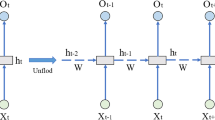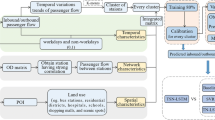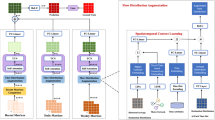Abstract
Short-term origin–destination (OD) flow prediction is vital for operations planning, control, and management in urban railway systems. While the entry and exit passenger demand prediction problem has been studied in various studies, the OD passenger flow prediction problem receives much less attention. One key challenge for short-term OD flow prediction is the partial observability of the OD flow information due to trips having not been completed at a certain time interval. This paper develops a novel deep learning architecture for the OD flow prediction in urban railway systems and examines various mechanisms for data representation and for dealing with partial information. The deep learning framework consists of three main components, including multiple LSTM networks with an attention mechanism capturing short/long-term temporal dependencies, a temporally shifted graph matrix for spatiotemporal correlations, and a reconstruction mechanism for partial OD flow observations. The model is validated using smart card data from Hong Kong’s Mass Transit Railway (MTR) system and compared with state-of-the-art prediction models. Experiments are designed to examine the characteristics of the proposed approach and its various components. The results show the superior performance (accuracy and robustness) of the proposed model and also the importance of partial observations of OD flow information in improving prediction performance. In terms of data representation, predicting the deviation of OD flows performs consistently better than predicting OD flows directly.






Similar content being viewed by others
References
Hao S, Lee DH, Zhao D (2019) Sequence to sequence learning with attention mechanism for short-term passenger flow prediction in large-scale metro system. Transp Res Part C Emerg Technol 107:287–300
Liu Y, Liu Z, Jia R (2019) DeepPF: A deep learning based architecture for metro passenger flow prediction. Transp Res Part C Emerg Technol 101:18–34
Ma X, Zhang J, Du B, Ding C, Sun L (2018) Parallel architecture of convolutional bi-directional LSTM neural networks for network-wide metro ridership prediction. IEEE Trans Intell Transp Syst 20(6):2278–2288
Liu L, Qiu Z, Li G, Wang Q, Ouyang W, Lin L (2019) Contextualized spatial-temporal network for taxi origin-destination demand prediction. IEEE Trans Intell Transp Syst 20(10):3875–3887
Wang Y, Yin H, Chen H, Wo T, Xu J, Zheng K (2019) Origin-destination matrix prediction via graph convolution: a new perspective of passenger demand modeling. In:Proceedings of the 25th ACM SIGKDD International Conference on Knowledge Discovery & Data Mining, 1227–1235
Anvari S, Tuna S, Canci M, Turkay M (2016) Automated Box-Jenkins forecasting tool with an application for passenger demand in urban rail systems. J Adv Transp 50(1):25–49
Moreira-Matias L, Gama J, Ferreira M, Mendes-Moreira J, Damas L (2013) Predicting taxi-passenger demand using streaming data. IEEE Trans Intell Transp Syst 14(3):1393–1402
Zhang C, Song R, Sun Y (2011) Kalman filter-based short-term passenger flow forecasting on bus stop. J Transp Syst Eng Inf Technol 11(4):154–159
Jiao P, Li R, Sun T, Hou Z, Ibrahim A (2016) Three revised kalman filtering models for short-term rail transit passenger flow prediction. Math Probl Eng
Sun Y, Leng B, Guan W (2015) A novel wavelet-SVM short-time passenger flow prediction in Beijing subway system. Neurocomputing 166:109–121
Ding C, Wang D, Ma X, Li H (2016) Predicting short-term subway ridership and prioritizing its influential factors using gradient boosting decision trees. Sustainability 8(11):1100
Roos J, Bonnevay S, Gavin G (2016) Short-term urban rail passenger flow forecasting: A dynamic bayesian network approach. In: 2016 15th IEEE International Conference on Machine Learning and Applications (ICMLA), 1034–1039
Tsai T-H, Lee C-K, Wei C-H (2009) Neural network based temporal feature models for short-term railway passenger demand forecasting. Expert Syst Appl 36(2):3728–3736
Zhao S-Z, Ni T-H, Wang Y, Gao X-T (2011) A new approach to the prediction of passenger flow in a transit system. Comput Math Appl 61(8):1968–1974
Wei Y, Chen MC (2012) Forecasting the short-term metro passenger flow with empirical mode decomposition and neural networks. Transp Res Part C Emerg Technol 21(1):148–162
Guo J, Huang W, Williams BM (2014) Adaptive Kalman filter approach for stochastic short-term traffic flow rate prediction and uncertainty quantification. Transp Res Part C Emerg Technol 43:50–64
Hochreiter S, Schmidhuber J (1997) Long short-term memory. Neural Comput 9(8):1735–1780
Duan Y, Lv Y, Wang F-Y (2016) Travel time prediction with LSTM neural network. In IEEE 19th International Conference on Intelligent Transportation Systems (ITSC), 1053–1058
Ma X, Tao Z, Wang Y, Yu H, Wang Y (2015) Long short-term memory neural network for traffic speed prediction using remote microwave sensor data. Transp Res Part C Emerg Technol 54:187–197
Xu J, Rahmatizadeh R, Bölöni L, Turgut D (2017) Real-time prediction of taxi demand using recurrent neural networks. IEEE Trans Intell Transp Syst 19(8):2572–2581
Yao H, Tang X, Wei H, Zheng G, Li Z (2019) Revisiting spatial-temporal similarity: a deep learning framework for traffic prediction. Proc AAAI Conf Artif Intell 33:5668–5675
LeCun Y, Bottou L, Bengio Y, Haffner P (1998) Gradient-based learning applied to document recognition. Proc IEEE 86(11):2278–2324
Ke J, Zheng H, Yang H, Chen X (2017) Short-term forecasting of passenger demand under on-demand ride services: A spatio-temporal deep learning approach. Transp Res Part C Emerg Technol 85:591–608
Yao H, Wu F, Ke J, Tang X, Jia Y, Lu S, Gong P, Li Z, Ye J, Chuxing D (2018) Deep multi-view spatial-temporal network for taxi demand prediction. In: 32nd AAAI Conference on Artificial Intelligence, AAAI 2018, 2588–2595
Du B, Peng H, Wang S, Bhuiyan MZA, Wang L, Gong Q, Li J (2019) Deep irregular convolutional residual LSTM for urban traffic passenger flows prediction. IEEE Trans Intell Transp Syst 21(3):972–985
Chu KF, Lam AY, Li VO (2019) Deep multi-scale convolutional LSTM network for travel demand and origin-destination predictions. IEEE Trans Intell Transp Syst 21(8):3219–3232
Ke J, Qin X, Yang H, Zheng Z, Zhu Z, Ye J (2021) Predicting origin-destination ride-sourcing demand with a spatio-temporal encoder-decoder residual multi-graph convolutional network. Transp Res Part C Emerg Technol 122:102858
Noursalehi P, Koutsopoulos HN, Zhao J (2021) Dynamic origin-destination prediction in urban rail systems: a multi-resolution spatio-temporal deep learning approach. IEEE Trans Intell Transp Syst
Kipf TN, Welling M (2016) Semi-supervised classification with graph convolutional networks. In International Conference on Learning Representations (ICLR), 2017
Yu B, Yin H, Zhu Z (2018) Spatio-temporal graph convolutional networks: a deep learning framework for traffic forecasting. In: Proceedings of the 27th International Joint Conference on Artificial Intelligence (IJCAI-18), 2018
Chai D, Wang L, Yang Q (2018) Bike flow prediction with multi-graph convolutional networks. In: Proceedings of the 26th ACM SIGSPATIAL International Conference on Advances in Geographic Information Systems, 397–400
Geng X, Li Y, Wang L, Zhang L, Yang Q, Ye J, Liu Y (2019) Spatiotemporal multi-graph convolution network for ride-hailing demand forecasting. Proc AAAI Conf Artif Intell 33:3656–3663
Guo S, Lin Y, Feng N, Song C, Wan H (2019) Attention based spatial-temporal graph convolutional networks for traffic flow forecasting. Proc AAAI Conf Artif Intell 33:922–929
Noursalehi P, Koutsopoulos HN, Zhao J (2018) Real time transit demand prediction capturing station interactions and impact of special events. Transp Res Part C Emerg Technol 97:277–300
Paszke A, Gross S, Chintala S, Chanan G, Yang E, DeVito Z, Lin Z, Desmaison A, Antiga L, Lerer A (2017) Automatic differentiation in pytorch
Luong MT, Pham H, Manning CD (2015) Effective approaches to attention-based neural machine translation. In: Proceedings of the 2015 Conference on Empirical Methods in Natural Language Processing, 2015
Zhang K, Liu Z, Zheng L (2019) Short-term prediction of passenger demand in multi-zone level: Temporal convolutional neural network with multi-task learning. IEEE Trans Intell Transp Syst 21(4):1480–1490
Kamarianakis Y, Prastacos P (2003) Forecasting traffic flow conditions in an urban network: Comparison of multivariate and univariate approaches. Transp Res Record 1857(1):74–84
Zhang Z, Li M, Lin X, Wang Y, He F (2019) Multistep speed prediction on traffic networks: a deep learning approach considering spatio-temporal dependencies. Transp Res Part C Emerg Technol 105:297–322
Gers FA, Eck D, Schmidhuber J (2002) Applying LSTM to time series predictable through time-window approaches. In Neural Nets WIRN Vietri-01, 193–200
Rodrigues F, Markou I, Pereira FC (2019) Combining time-series and textual data for taxi demand prediction in event areas: A deep learning approach. Information Fusion 49:120–129
Acknowledgements
The authors would like to thank MTR, Hong Kong for providing the data, the Massachusetts Green High-Performance Computing Center (MGHPCC) for support on computing. The research is supported by the Monash Faculty of Engineering travel grant and Monash seed funding.
Author information
Authors and Affiliations
Corresponding author
Ethics declarations
Conflict of interest
The authors declare that they have no conflict of interest.
Additional information
Publisher's Note
Springer Nature remains neutral with regard to jurisdictional claims in published maps and institutional affiliations.
Rights and permissions
About this article
Cite this article
Jiang, W., Ma, Z. & Koutsopoulos, H.N. Deep learning for short-term origin–destination passenger flow prediction under partial observability in urban railway systems. Neural Comput & Applic 34, 4813–4830 (2022). https://doi.org/10.1007/s00521-021-06669-1
Received:
Accepted:
Published:
Issue Date:
DOI: https://doi.org/10.1007/s00521-021-06669-1




